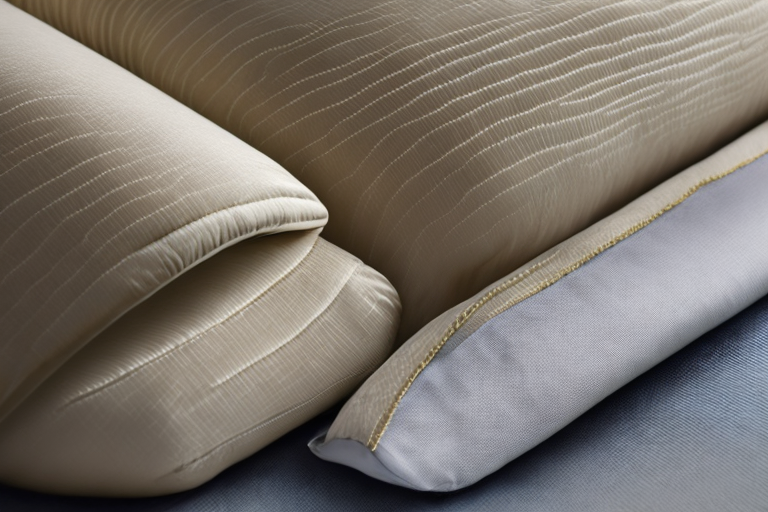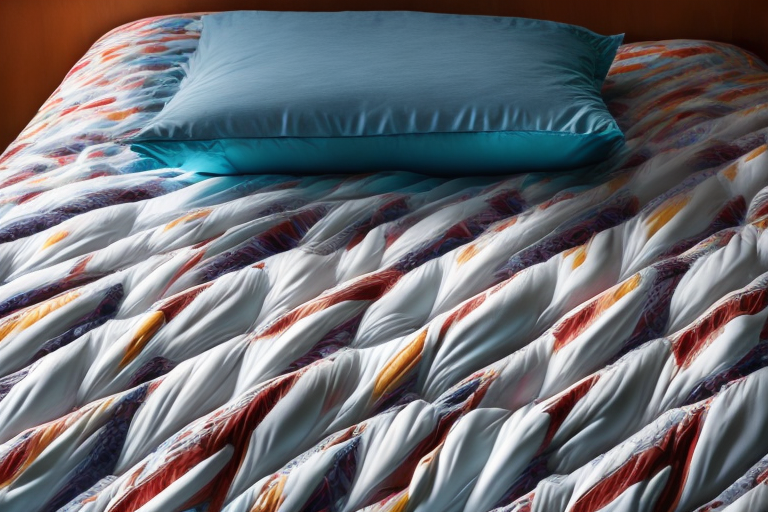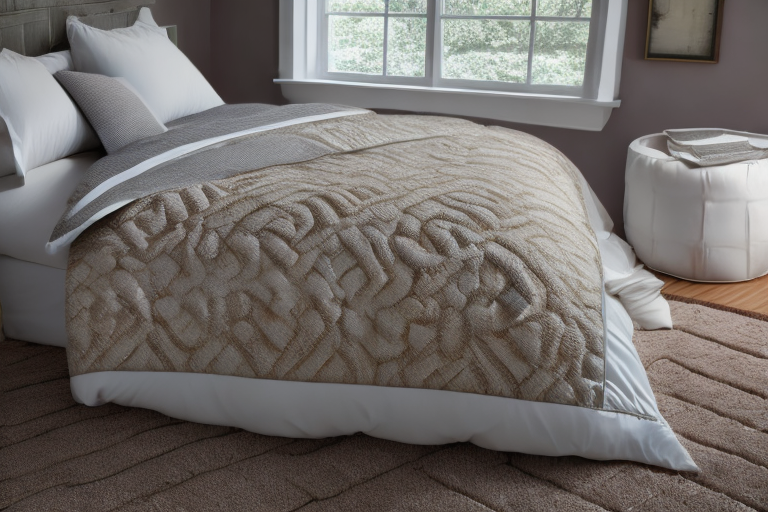Do you love the warm, fluffy comfort of a down-filled comforter but can’t stand the crinkling sound it makes every time you move? You’re not alone. While down comforters provide unbeatable levels of softness and insulation, their potential to generate noise can disrupt sleep for many users.
The good news is that not all down comforters make noise, and there are steps you can take to choose one that will remain noiseless all night long. This beginner’s guide covers everything you need to know about how down type, fill power, shell materials, construction quality, proper care and more affect noise levels. Follow our tips to find a luxuriously comfortable and whisper-quiet down comforter optimized for peaceful slumber.
What Factors Contribute to Noise in Down Comforters?
Before delving into noise reduction tips, let’s look at why some down comforters make noise in the first place while others remain silent.
Shell Fabric
The outer shell enclosing the down fill plays a major role in deadening sound. Lower thread counts around 200-300 lead to more audible rustling, while finer cottons over 500 TC help dampen noise. Most premium hotel-style down comforters use a 300-thread count 100% cotton cover for optimal softness and durability.
Fill Power
This measures the loft or fluffiness of the down fill. Higher fill powers around 600-800+ expand better to insulate and buffer noise. Lower fill down around 300-400 FP compresses more easily to transmit rustling sounds.
Construction Style
Baffle box comforters with internal fabric walls prevent fill from shifting to contain noise. Sewn-through designs with stitching directly through the fill tend to be louder with more fill movement.
| Construction Style | Noise Level |
|---|---|
| Baffle Box | Low |
| Sewn-Through | High |
With the key factors identified, let’s move onto to practical steps for choosing an ultra-quiet down comforter.
Choose High Thread Count Cotton Shells
Premium long-staple cotton with a tightly woven high thread count over 500 is ideal for muffling noise. Skip cheaper polyshells, which tend to make more rustling sounds.
Aim for a 300-500 TC cotton cover with a subtle sateen weave for the perfect balance of durability, breathability and noise blocking. If you prefer crispy hotel bedding, 300 TC will replicate that smooth, cool feel. For added softness, look for 500+ TC options.
Prioritize High Fill Power

Higher fill power down around 600-800+ FP will insulate better and resist shifting around to cut down on noise. It also allows the use of less fill to achieve equal warmth, resulting in a lighter, more malleable comforter.
As a rule of thumb, the higher the fill power the less noise:
- 300-400 FP – Affordable but more audible noise
- 600-700 FP – Ideal warmth-to-weight ratio, less noise
- 800+ FP – Maximum loft and insulation, ultra-quiet
Choose Baffle Box Construction
This superior construction style contains the fill within fabric compartments or “baffles” to limit sound-causing movement. Baffle box down comforters maintain consistent fluffiness and minimal noise over time.
The sewn-through method with stitching directly through the fill is cheaper but allows the interior layers to shift around easily and generate crackling noises. Stick to baffle box for serene slumber.
Wash Properly in Cold Water
Follow the care instructions for washing down comforters in cold water on a gentle cycle. Never use fabric softeners or bleach – these can strip natural oils leading to moisture retention issues.
After washing, dry thoroughly on low heat, adding a couple tennis balls to the dryer to redistribute filling and fluff the comforter back up. Proper drying is key to prevent dampness leading to mold, clumping and excess noise.
Shield Comforter in Duvet Cover
An oversized cotton duvet acts as a protective barrier against body oils and moisture that could compromise the down. Tightly woven covers also help muffle any potential sounds.
For severe allergy sufferers, dust-mite resistant duvets add an extra noise blocking layer. Just make sure to still wash the underlying comforter regularly as buildup can cause crinkling.
[Image showing a down comforter inside a duvet cover]
Comparison Chart: Noise Levels of Popular Down Comforter Types
| Comforter Type | Noise Level | Price Range |
|---|---|---|
| White Goose Down | Very low | $$$ |
| Grey Goose Down | Very low | $$$$ |
| Siberian Goose Down | Low | $$ |
| European Duck Down | Low | $$ |
| Domestic Duck Down | Medium | $ |
| Down Alternative | High | $ |
As shown in the chart, soft, fluffy white goose down and grey goose down make the least noise, but come at a higher cost. Proven hypoallergenic options like Siberian goose down are also excellent at sound insulation without the high price tag.
Cheaper domestic duck down tends to be louder with more fill shifting. Synthetic down alternatives filled with microfiber make the most noise, less able to replicate the acoustic properties of premium waterfowl down.
Top Expert Recommendations for Ultra-Quiet Down Comforters

We asked bedding specialists which specific down comforters they suggest for a minimal disturbance sleep experience:
“We always recommend the Brooklinen Down Comforter to customers wanting hotel luxury with no noise. The premium 700 fill power European down and 400 thread count cotton shell are perfectly designed for peaceful nights.”
“The Buffy Cloud Comforter is a great eco-friendly option, using 100% recycled materials in a patented thread-less permeable shell that allows airflow without rustling noises.”
“For year-round use in any climate, the Tuft & Needle Down Comforter is expertly crafted using soft, ethical down insulation wrapped in a smooth 300 thread count cover to eliminate disturbance.”
Don’t be afraid to invest some extra budget into purchasing a quality down comforter featuring the construction details that contribute to an overall hushed and comfortable sleeping experience. Your rest is worth it!
The Bedding Environment Matters Too
A top-notch soundproof down comforter alone does not a silent sleeper make. Optimizing your overall sleep environment is crucial for noise reduction and restful slumber.
Here are some bedding upgrades to complement your high-end hypoallergenic comforter purchase:
- Premium cotton sheets over 200 thread count
- Wool mattress pad for moisture-wicking
- High density foam mattress to absorb sound
- Bed suspension system to minimize motion transfer
- Blackout curtains in the bedroom for darkness
It’s the combination of an expertly made down comforter within a dialed-in sleep sanctuary that will have you catching quality Zzz’s without interruption or disturbances. The difference in both energy levels and productivity you feel from improved rest will be immediate and substantial.
Be Mindful of Down Comforters Year Round
As a final note, take seasonality into account when using your down comforter for maximum comfort and minimum noise:
Winter – Fluff comforter and allow full lofting for best insulation and sound dampening
Summer – Gently compress filling for lighter, less noisy coverage to prevent overheating
Making a few small adjustments like this based on climate will keep you sleeping soundly all year long. The perfect down comforter is truly an all-season bedding investment.
In Conclusion: Keep Calm and Snooze On
We’ve covered all the design factors, from shell fabric to construction to hypoallergenic filling and proper care, required to choose a plush yet peaceful down comforter. Follow these expert tips as your guide to experiencing the age-old comfort of down with none of the disruptive crackling or rustling noises.
With your newfound understanding of optimal materials and methods used by leading bedding brands worldwide to achieve that elusive combination of indulgent comfort and undisturbed quiet, you can now confidently upgrade your bedding situation. Replace the old noisy down comforter that has been keeping you up with a new premium quality version designed for dreamy, restorative sleep.
Frequently Asked Questions
What is the quietest down comforter fill?
Premium white goose down and grey goose down offer the most sound dampening properties. The high loft and insulation capacity resist shifting to prevent rustling noises. Siberian goose down and European duck down are also excellent affordable options for minimal noise.
What thread count is best for a quiet down comforter?
Look for a tightly woven 300-500 thread count cotton shell. Over 500 TC can feel excessively stiff and crinkly, while under 300 TC the weave is prone to more fill leakage and crackling sounds. The sweet spot is a 400-500 TC cotton cover for optimal durability, breathability and noise blocking.
Is baffle box or sewn-through construction better to reduce noise?
Baffle box construction contains the down filling within quilted fabric walls to limit sound-causing shift and clumping. The sewn-through method allows the insulation to move around more freely creating audible rustling. Baffle box is vastly superior for maintaining consistent comfort and quietness.
How often should you wash a down comforter to prevent noise?
Wash down comforters 2-3 times per year in cold water on a gentle cycle, with mild detergent. Skip the fabric softener, and dry thoroughly on low heat with tennis balls. Allowing moist buildup causes mold, clumping and crackling sounds. Proper maintenance is key!
What’s the best duvet cover fabric for noise reduction?
An oversized 300-500 thread count cotton duvet cover with a tight weave not only protects the comforter but also helps muffle any underlying sounds. Noise-blocking microfiber and durable polyester blends work as well. Just make sure duvet fabric feels soft, not crispy.








